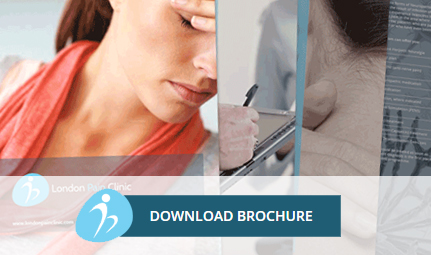“As our Pain Doctors will explain to you: “the first indication that Botox could be useful for treating pain was observed from anecdotal reports of patients treated for hyperfunctional facial lines who reported reduced frequency and severity of headache. Soon thereafter, the pain-relieving effect of Botox was reported during the treatment of oromandibular dystonia & cervical dystonia. Today, Botox is used for pain relief in numerous conditions including tension headaches, migraine headaches, post-herpetic neuralgia & myofacial TMD” [1]
The Low-Down on TMJ
TMJ (temporomandibular joint syndrome) refers to an umbrella term which encompasses any category of dysfunction that incorporates the joints in the temporomandibular region. Symptoms may comprise:
- Muscle spasms
- Swollen muscles
- Facial pain
- Swelling
- Enlarged lymph nodes around the neck [2]
When you contact us here at the London Pain Clinic, we will schedule you in for an online or in-person appointment with one of our Pain Consultants. During this time, they will review your medical history and ask you various pertinent questions. They will then arrange any necessary examination, tests or scans. After this, once they have given you an accurate diagnosis, they will devise a Holistic Personalised Treatment Plan that you can get started on right away. This may be multi-faceted, and include both conventional treatment and state-of-the-art treatments, therapies and injectables (including Botox).
TMJ Symptoms to Report to Your Pain Specialist
Symptoms linked to temporomandibular joint syndrome can vary according on the intensity of the disorder. The most common ones that we see at the London Pain Clinic, include:
- Pain in the jaw
- Facial Pain
- Muscle tenderness in the facial region – this is the most prevalent symptom, and if the pain is intense, then the knock-on effect can negatively impact speaking, eating, and other normal functions. Moreover, the deep pain can result in muscle weakness, and the sufferer can feel tired
- Trouble closing or opening the mouth. – This can come about from a locked jaw, stiffness or pain
- Popping or clicking whilst moving the jaw. – This can come about when the jaw joint is out of alignment, or damaged
- Neck pain, long-term migraines and earache: as your Pain Consultant will inform you: “TMJ pain can radiate to the head and neck, causing chronic migraines and neck pain. TMJ pain can also radiate to the ears, causing earaches” [2]
So How Does Botox Relieve TMJ?
When your Pain Consultant administers Botox into the muscles surrounding your temporomandibular joint, your joint tension will be considerably reduced. This is due to the fact that the Botox relaxes the muscles in your jaw. To that end, by opting for this procedure (as long as you are a suitable candidate), you can expect alleviation from the discomfort and pain generated by temporomandibular joint syndrome.
Teeth Grinding
In addition to the aforementioned, our Pain Doctors frequently administer Botox injections to help patients stop grinding their teeth. – Teeth Grinding is a disorder which often exacerbates TMJ symptoms.
The Multiple Benefits of TMJ Botox
- Minimally invasive and non-surgical
- Quick procedure which can easily be administered by your ain Specialist in your lunch time or after work
- Safe treatment when conducted by a Pain Doctor
- Effective in substantially relieving pain, stiffness, and other symptoms of TMJ [2]
References
[1]. Mor N, Tang C, Blitzer A. Temporomandibular Myofacial Pain Treated with Botulinum Toxin Injection. Toxins (Basel). 2015 Jul 24;7(8):2791-800. As cited by the National Institutes of Health.
https://pmc.ncbi.nlm.nih.gov/articles/PMC4549724/
[3]. Olympic View (2023). “Everything You Should Know About Botox For TMJ.”



